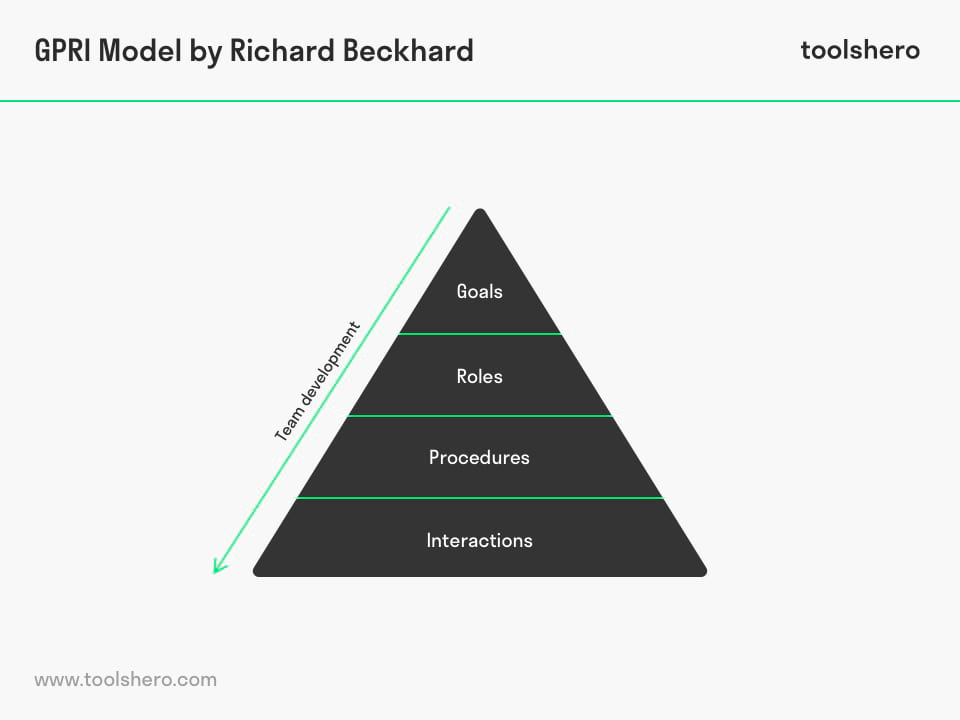GRPI Model of Team Effectiveness (Beckhard)

GRPI Model of Team Effectiveness: this article provides a practical explanation of GRPI Model of Team Effectiveness, developed by Richard Beckhard. Next to what it is, this article also highlights the importance of Team Development, the components like Goals, Roles, Procedures en Interactions. After reading, you’ll have a basic understanding of this powerful management tool. Enjoy reading!
What is the GRPI Model of Team Effectiveness?
In the 1970s, the American organisational development scientist Richard Beckhard discovered that there are mutual dependencies in a working process.
These are decisive within an organisation. He addressed four themes for which it is necessary to get clarity, agreement, and support within the team, which resulted in the GRPI Model. GRPI is an acronym that stands for Goals, Roles, Procedures and Interactions.
This GRPI Model can be used to look at teams and question them on all aspects of their cooperation (teamwork).
Team Development
A team or department will often begin to work without any clarity about end goals having been given beforehand. This means the distribution of roles is far from always clear, which can lead to poor communication, misunderstandings, and potential conflicts.
A team can only do their job effectively if they discover together what they stand for and what they are working towards. That means that, among other things, they will have to better organise their work processes.
Within this team development, this will lead to their mutual interaction improving, their commitment to one another increasing, and personal relationships becoming more enjoyable. Team development as a whole is an iterative process, the buildup of which starts with a good foundation.
This is exactly what the GRPI Model aims for. It starts with discovering the team or department goal. From there, the distribution of roles needs to be clear and only then can procedures and processes be written out. This will eventually result in improved interpersonal relationships and interaction.

Figure 1 – GPRI Model of Team Effectiveness
It’s not just about optimally accomplishing tasks. Energy also needs to be invested into the mutual relationships and coordination with one another. With his GRPI Model, Beckhard shows that teams don’t function well when this does not receive attention, and each team member works for themselves instead.
Teambuilding only happens when each team member invests into it and puts their shoulders to the wheel. When support is chosen, it is preferred to call on the services of an objective, internal or external consultant (third party intervention) for this.
A closer look at the GRPI Model of Team Development
Below, all four parts of the GRPI Model are looked at in more detail.
Goals
First of all, the goal and/ or the assignment should be clear to the whole team. This is the foundation for a well-functioning team. From the strategic level, this is where the organisation’s mission and vision are nestled.
By translating this into tactical, department-oriented SMART Goals, it will be clear what is expected of a team. These department objectives will then have to be translated into individual operational objectives, so that each team member knows what their contribution should be and what is expected of them.
Goals give guidance to a team and offer insight into its progress, as well as possible delays it may run into. A common goal will ensure that the members of a team will better understand and accept one another. They will be better able to commit to a common goal.
By not imposing an objective on them directively (top down), but inviting them to come up with their own thoughts about it (bottom up), they will be more loyal and better able to find the strength to pursue this goal. It is preferred to make the team objective SMART: Specific, Measurable, Attainable, Relevant, and Timely.
Periodic measuring and evaluation moments ensure that enough control and adjustment is possible and that team members can address each other about deadlines.
It’s mostly about ‘what’ is expected of them. When everyone knows exactly what result is being worked toward, it’s easier to set priorities i.e. using the Eisenhower Matrix. Weekly work meetings is an excellent way of discussing the common team goal.
Roles
Within the GRPI Model, this is about the roles each team member fulfils. A job role is determined by the tasks that belong to it. The question is to what extent these roles and responsibilities are defined, and how they are accepted by each employee.
As soon as someone is uncomfortable with the role they’ve been given, this will have a negative effect on their performance. Employees usually feel responsible for their own tasks. That’s why each team member needs to have a clear image of the TAR package consisting of tasks, authorities, and responsibilities.
As soon as any confusion exists with regard to this, employees will no longer take their own responsibility. That’s why it’s crucial that employees be satisfied and agree to their tasks and responsibility.
This is about ‘who’ does what. Without the foundation of a clear goal, connecting tasks and roles to this is quite a difficult job. That’s why each role should be supported by the previously defined goals. Only then will team members be able to cooperate well in order to achieve the eventual goal.
Apart from the roles, it’s also about the expectations team members have of one another. As long as any uncertainty or disagreement exists with regard to these, no one will take their responsibility.
Procedures
After defining the roles, it’s time for the procedures, processes, and working arrangements. These are meant to support the team. By defining team processes in the area of communication, decision making, conflict management, everyone will know exactly what is expected of them.
This will result, among other things, in standardised work processes, decision making, conflict handling, problem solving, and clearly defined procedures. Arrangements about mutual cooperation and interaction within the team are part of these procedures as well. Because of them, the team is better able to cooperate effectively and take quick action.
This is mostly about ‘how’ the team works. Working effectively requires uniform methods. Unambiguous arrangements create calm and a feeling of security and safety. A lack of procedures will mostly lead to uncertainty and be cause for discussions and conflicts.
Interactions
Once the procedures have been secured as well, the GRPI Model notes it’s time to look at mutual relationships. Is there enough cohesion, mutual trust, an open communication culture, and a good work climate?
Interaction is about the interpersonal relationships between employees. To what extent do they like one another, are they there for one another, do they support and stimulate one another?
Building up trust is an abstract concept, which is reflected in a safe environment. Does everyone within the team feel understood and heard? To what extent do team members talk to each other, rather than about each other (gossip)?
There are various options for improving these interpersonal relationships between employees. This could start with something as simple as giving compliments and focusing on the things that have gone well.
Negativity is killing for a good atmosphere and working together well. Showing understanding toward one another, greeting colleagues from other departments, and listening to a colleague’s story are examples of small investments that enhance and improve the interpersonal relationship.
Here, too, we are talking about an abstract concept that can only grow through smooth mutual communication. In a comfortable and respectful atmosphere, employees are better able to develop, as well as feel supported.
GRPI Model: Wrong way around
Beckhard observed that many managers and internal or external consultants make the mistake of first focusing on the interpersonal relationships at a department. From there, they work the wrong way around, toward the procedures, roles and tasks, finishing with the department goal.
Beckhard states that this is a wrong way of thinking, which makes it almost impossible to sort out inter-team cooperation. According to his GRPI Model, one is a consequence of the other.
He emphasises the importance of clear prioritising, with the goal as the base. Only then can the GRPI Model help to produce an efficient team.
Now it’s your turn
What do you think? Do you recognize the explanation of the GRPI Model? What do you think are success factors for team development? Do you have any tips or comments?
Share your experience and knowledge in the comments box below.
More information
- Beckhard, R. (1972). Optimizing team-building efforts. Journal of Contemporary Business, 1(3), 23-32.
- Beckhard, R. (1992). A model for the executive management of transformational change.
- Rubin, I. M., & Beckhard, R. (1972). Factors influencing the effectiveness of health teams. The Milbank Memorial Fund Quarterly, 50(3), 317-335.
How to cite this article:
Mulder, P. (2019). GRPI Model of Team Effectiveness (Beckhard). Retrieved [insert date] from Toolshero: https://www.toolshero.com/management/grpi-model/
Published on: 03/14/2019 | Last update: 02/16/2023
Add a link to this page on your website:
<a href=”https://www.toolshero.com/management/grpi-model/”>Toolshero: GRPI Model of Team Effectiveness (Beckhard)</a>












